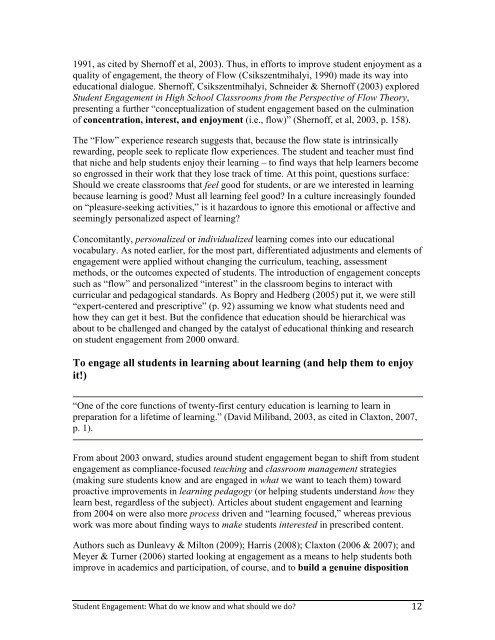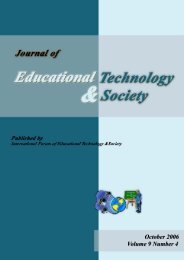Student Engagement: What do we know and what should we do?
Student Engagement: What do we know and what should we do?
Student Engagement: What do we know and what should we do?
Create successful ePaper yourself
Turn your PDF publications into a flip-book with our unique Google optimized e-Paper software.
1991, as cited by Shernoff et al, 2003). Thus, in efforts to improve student enjoyment as a<br />
quality of engagement, the theory of Flow (Csikszentmihalyi, 1990) made its way into<br />
educational dialogue. Shernoff, Csikszentmihalyi, Schneider & Shernoff (2003) explored<br />
<strong>Student</strong> <strong>Engagement</strong> in High School Classrooms from the Perspective of Flow Theory,<br />
presenting a further “conceptualization of student engagement based on the culmination<br />
of concentration, interest, <strong>and</strong> enjoyment (i.e., flow)” (Shernoff, et al, 2003, p. 158).<br />
The “Flow” experience research suggests that, because the flow state is intrinsically<br />
rewarding, people seek to replicate flow experiences. The student <strong>and</strong> teacher must find<br />
that niche <strong>and</strong> help students enjoy their learning – to find ways that help learners become<br />
so engrossed in their work that they lose track of time. At this point, questions surface:<br />
Should <strong>we</strong> create classrooms that feel good for students, or are <strong>we</strong> interested in learning<br />
because learning is good? Must all learning feel good? In a culture increasingly founded<br />
on “pleasure-seeking activities,” is it hazar<strong>do</strong>us to ignore this emotional or affective <strong>and</strong><br />
seemingly personalized aspect of learning?<br />
Concomitantly, personalized or individualized learning comes into our educational<br />
vocabulary. As noted earlier, for the most part, differentiated adjustments <strong>and</strong> elements of<br />
engagement <strong>we</strong>re applied without changing the curriculum, teaching, assessment<br />
methods, or the outcomes expected of students. The introduction of engagement concepts<br />
such as “flow” <strong>and</strong> personalized “interest” in the classroom begins to interact with<br />
curricular <strong>and</strong> pedagogical st<strong>and</strong>ards. As Bopry <strong>and</strong> Hedberg (2005) put it, <strong>we</strong> <strong>we</strong>re still<br />
“expert-centered <strong>and</strong> prescriptive” (p. 92) assuming <strong>we</strong> <strong>know</strong> <strong>what</strong> students need <strong>and</strong><br />
how they can get it best. But the confidence that education <strong>should</strong> be hierarchical was<br />
about to be challenged <strong>and</strong> changed by the catalyst of educational thinking <strong>and</strong> research<br />
on student engagement from 2000 onward.<br />
To engage all students in learning about learning (<strong>and</strong> help them to enjoy<br />
it!)<br />
“One of the core functions of t<strong>we</strong>nty-first century education is learning to learn in<br />
preparation for a lifetime of learning.” (David Milib<strong>and</strong>, 2003, as cited in Claxton, 2007,<br />
p. 1).<br />
From about 2003 onward, studies around student engagement began to shift from student<br />
engagement as compliance-focused teaching <strong>and</strong> classroom management strategies<br />
(making sure students <strong>know</strong> <strong>and</strong> are engaged in <strong>what</strong> <strong>we</strong> want to teach them) toward<br />
proactive improvements in learning pedagogy (or helping students underst<strong>and</strong> how they<br />
learn best, regardless of the subject). Articles about student engagement <strong>and</strong> learning<br />
from 2004 on <strong>we</strong>re also more process driven <strong>and</strong> “learning focused,” whereas previous<br />
work was more about finding ways to make students interested in prescribed content.<br />
Authors such as Dunleavy & Milton (2009); Harris (2008); Claxton (2006 & 2007); <strong>and</strong><br />
Meyer & Turner (2006) started looking at engagement as a means to help students both<br />
improve in academics <strong>and</strong> participation, of course, <strong>and</strong> to build a genuine disposition<br />
<strong>Student</strong> <strong>Engagement</strong>: <strong>What</strong> <strong>do</strong> <strong>we</strong> <strong>know</strong> <strong>and</strong> <strong>what</strong> <strong>should</strong> <strong>we</strong> <strong>do</strong>? 12












